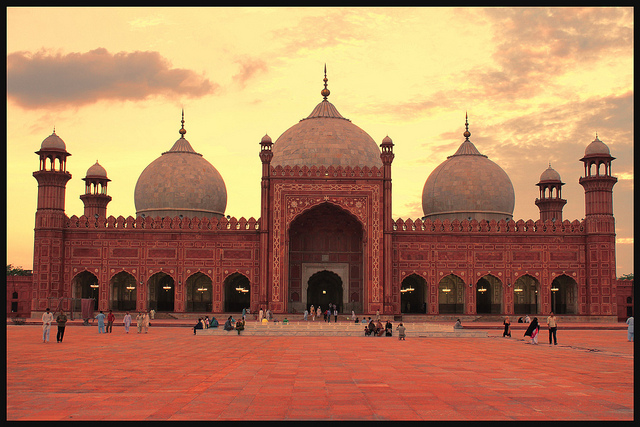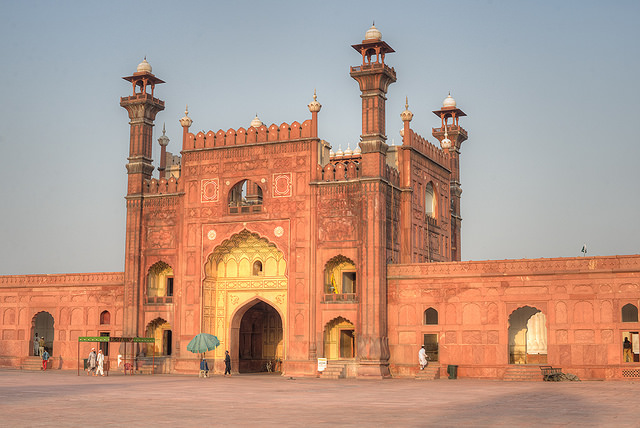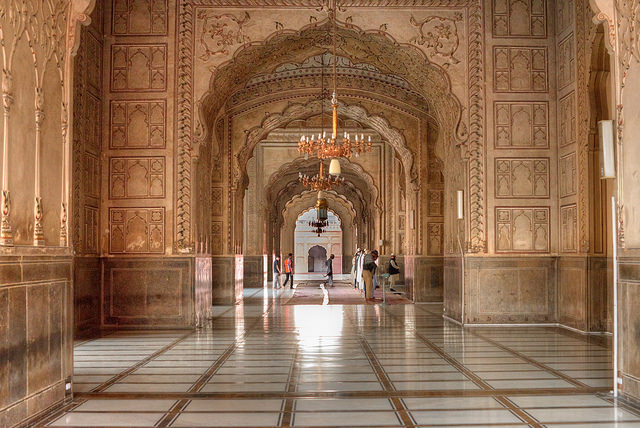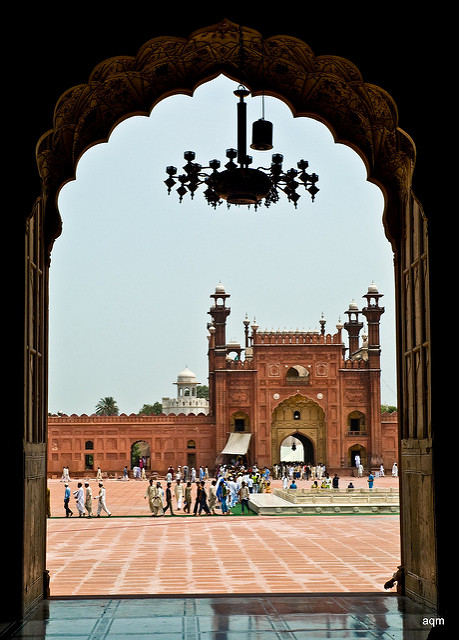Anyone visiting Pakistan must stop in the city of Lahore. Located in the Punjab province, Lahore is one of the most culturally significant cities in the South Asian nation. Everyone who is fortunate enough to fly into Lahore will undoubtedly want to visit the iconic Badshahi Mosque first. This huge mosque is one of the most important examples of Mughal architecture and remains an important symbol of Pakistan.
Sometimes called the Lahore Emperor Mosque, the Badshahi Mosque was built between 1671 and 1673. Emperor Aurangzeb ordered the construction of the mosque to protect a strand of the Prophet Mohammed’s hair. Historians say Aurangzeb took inspiration for the design of this mosque from the Jama Mosque built in Delhi.

The Badshahi Mosque was the largest in the Islamic world for hundreds of years. Each side of this construction measures around 170 meters. Skilled architects used red sandstone and marble in the construction of this monumental mosque. Although the Badshahi Mosque no longer holds the distinction of the largest mosque in the world, it is the largest and best preserved mosque from the Mughal era.

For those who don’t know, Emperor Aurangzeb lived from 1618-1707 and reigned over much of southern Asia for almost 50 years. His great skill in battle led him to control over three million square kilometers of land. Emperor Aurangzeb greatly expanded the Mughals’ control and is seen as one of the most effective generals in history. Sadly, after Emperor Auangzeb’s death the Mughal Empire began to slowly decline in power.
Interestingly, the Badshahi Mosque wasn’t used as a house of worship for most of its history. Once the Sikhs took power of the region in 1799, the mosque was used to house and train soldiers. The Sikhs’ army equipment and horses were all stored in and around this mosque. They also built the marble Hazuri Bagh Baradari in 1818 to watch over the mosque.

Many wars took place in the 1840s between the British and the Sikhs for control of Lahore. In 1849, the British finally took over the Sikhs Empire. Throughout the period of British colonial rule, the mosque still served as a military base.
As you could imagine, the local Muslim community didn’t like their beautiful mosque being used for military purposes. Many religious leaders called on the British to allow them to worship in their beloved mosque. So, in 1852, the British began a massive revitalization project on the mosque. After a few years, the mosque handed over to the Muslim community for its initial purpose: worship of Allah.

Refurbishment efforts at the mosque are still ongoing. The architect Nawab Alam Yar Jung Bahadur was extremely important in returning the mosque to its former glory in the 1930s and 40s. In recent years, Pakistanis have spent millions of dollars on refurbishing the Badshahi Mosque. A few new refurbishment projects include a marble inlay in the central prayer hall and new tiles in the courtyard. Also, all of the eight minarets at this complex have been restored to their former glory.
People who come into the Badshahi Mosque are often surprised by the heavy Persian influence throughout the complex. The first thing visitors see in this mosque’s entryway are the intricate carved paneling on the facades. There are a few upper chambers that aren’t open to the public. It’s said that two of these chambers have the hair of both the Prophet Mohammad and Mohammad’s famous son-in-law Ali.
This mosque’s beautiful courtyard measures 276,000 square feet. Believe it or not, over 100,000 people can comfortably fit here for special prayer services. Be sure to take some extra time to explore the gorgeous architecture around this area.
Of course, the most important spot for worshippers is the central prayer hall. As with the rest of this mosque, the primary material used in the construction of this prayer hall is red sandstone. There are, however, many white marble decorations in this area. Be sure to take a look at the gorgeous Mughal floral frescoes as you walk through this prayer hall. About 10,000 people can fit inside this prayer hall during service.

Visitors can find the Badshahi Mosque right next to the Lahore Fort, which has been designated an official UNESCO World Heritage Site. Anyone who wants to tour the Badshahi Mosque is asked to respect the local customs by wearing conservative attire. All women will be asked to wear a headdress before entering the mosque. Although there’s no fee for entering the mosque, you should bring along a few Pakistani Rupees to pay your shoekeeper on the way out.
Another important monument near the Badshahi Mosque is the impressive Tomb of Muhammad Iqbal. Constructed in the 1930s after Iqbal’s passing, this tomb is of great importance to the Pakistani people. Muhammad Iqbal was a prominent poet and philosopher that led charge for Pakistani independence. You’ll most likely see dozens of devoted Pakistanis visiting this tomb on your visit.

As you should be able to tell by now, there are tons of significant historical sites to visit in Lahore. Anyone interested in learning more about the history of this fascinating region of the world should spend a few days in this city. Besides visiting the Badshahi Mosque, a few other important areas include the Shahi Hammam, the Minar-e-Pakistan, and the Shalimar Gardens. To understand more about the culture of Lahore, visit the many museums in the area. Just a few of the most important museums in this city include the Lahore Museum, the Fakir Khana Museum, and the Shakir Ali Museum.
The Badshahi Mosque has been through a lot over the centuries. Despite the numerous wars and devastating earthquakes, the Badshahi Mosque still stands tall. Pakistanis take great pride in the long heritage and exquisite beauty of this national treasure. People interested in gaining a better appreciation of the Muslim faith and the historical importance of the Mughals should plan a visit to the Badshahi Mosque in the near-future.






